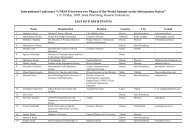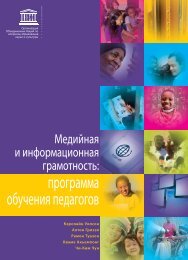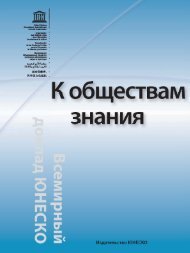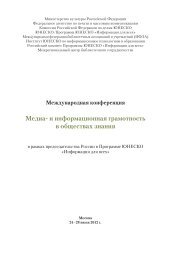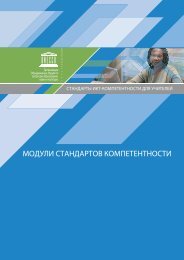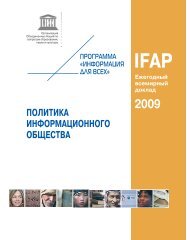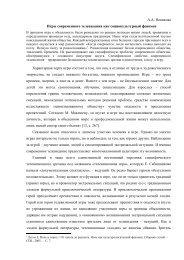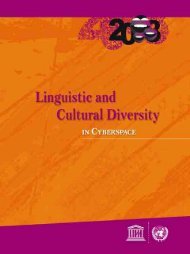Download - РоÑÑийÑкий комиÑÐµÑ ÐÑогÑÐ°Ð¼Ð¼Ñ Ð®ÐÐСÐÐ ...
Download - РоÑÑийÑкий комиÑÐµÑ ÐÑогÑÐ°Ð¼Ð¼Ñ Ð®ÐÐСÐÐ ...
Download - РоÑÑийÑкий комиÑÐµÑ ÐÑогÑÐ°Ð¼Ð¼Ñ Ð®ÐÐСÐÐ ...
Create successful ePaper yourself
Turn your PDF publications into a flip-book with our unique Google optimized e-Paper software.
social status In a multilingual situation, which are the other languages spoken<br />
in the same area All these questions can be answered in series of articles that<br />
fill several pages of a web site dedicated to the less-diffused language.<br />
As mentioned above, in order to increase the number of its speakers, a whole<br />
e-learning system can be built featuring sets of lessons for beginners, and other<br />
sets for advanced learners. Beginners’ lessons include phonetic exercises, and<br />
common sentences used in everyday life or typical social conversations, while<br />
advanced lessons introduce more to the people’s culture and literature aiming<br />
at a better mastership of the language. E-learning requires an important online<br />
interactivity between a local staff and a growing number of faraway students, each<br />
of whom should have a profile, a personal page and follow-up. Because everybody<br />
has different reasons to take lessons in any given language, it is a good practice to<br />
design the architecture of the whole course as a tree that allows different ways to<br />
progress through the lessons. Thus, each student can choose the better way for<br />
her/him, eventually with the advice of their teacher or mentor.<br />
2.3. The Language’s Speakers<br />
How many people speak the less-diffused language, either as native speakers or<br />
as second language speakers Do all the speakers share the same cultural area,<br />
way of life and custom A good description of these features provides content<br />
of a high interest. This includes all aspects of the society’s life such as social<br />
organization, administration, justice, labour, education, religion, philosophy,<br />
arts, food, architecture, transport, leisure and entertainment, and so forth.<br />
It is very common throughout the world that traditional communities develop<br />
a close relationship with specific animals they depend on for their life. For<br />
instance, a seal for the Inuits, a horse for the Mongolians, a cow for the Fulani,<br />
the Tutsi or the Texan cowboys, a sleigh dog for the Greenlanders, a reindeer<br />
for the Sami of northern Europe, a camel for the Sahara Tuaregs, a llama for the<br />
Indians in the Andes, a yak for the highlanders of Himalaya and neighboring<br />
regions, and so on. This special relationship between a specific animal and<br />
a human being community generates a very rich diversity in culture and<br />
civilization that all deserve being known to the whole mankind as a global<br />
human heritage. Who else can reveal them better than representatives of those<br />
traditional communities whose languages are usually less-diffused<br />
Finally, a social network web site would give the opportunity to the most<br />
committed supporters of the less-diffused language to enhance the language’s<br />
life on cyberspace by using it to chat and exchange all kind of messages and<br />
private data. By so doing, they automatically strengthen the vitality of the<br />
language that will thus become more and more used and diffused.<br />
125




